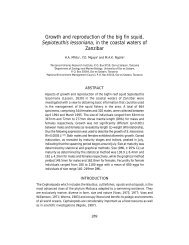Property impacts are widely known to depend on surrounding environmental amenity.Coastal and near-coast property is particularly vulnerable to environmental quality. To obtainbetter estimates of the environmental impacts on property value it is necessary to compareproperties with identical or similar characteristics (size, building quality, accessibility, etc.) inpolluted and pollution-free locations to isolate the impact of pollution. It would also bepreferable to use city zoning and land value maps to determine the proportion of residentialproperties falling within the “sphere of influence” of the coastal environment. In the CaseStudies, a conservative percentage of 5-10% reduction / appreciation of value is used on a20-25% of the housing market.The qualitative aspects are even more difficult to assess and require special ContingentValuation (CV) research results. The indirect effects of pollution on recreation (and thebenefits from pollution management) are classified in the Case Studies as qualitative due tolack of questionnaire data estimating people’s willingness-to-pay (WTP) for recreationalopportunities.In other words, the “total” benefits of sewerage infrastructure are under-estimated inthe Case Studies since, of lack of choice, they left out indirect and non-use benefitscomprising a very important category of benefits of potentially high socio-economicvalue, characterised as qualitative.To estimate indirect and particularly non-use benefits, CV studies are required. Such studiesare widely used tools to assess the social valuation of coastal and marine resources and theirbiodiversity significance (The Economic Value of Biodiversity, D. Pearce and D. Moran, 1996,also, Review of the Empirical Biodiversity Literature, Cynthia Cartier & Jack Ruitenbeek,2000). To assess total benefits, special studies should be carried out on resource valuationfocused on the social value of non-market benefits associated with conservation of coastaland marine ecosystems. When no value is given to the quality of non-market resources, dueto lack of estimates, decision-makers would still agree that ecosystem degradation is an"undesirable" environmental issue but may be encouraged to think of it as an issue beyondmanagement solutions and outside the ambit of environmental investment analysis. If such anapproach prevails, how will then proposals for increased investment for coastal zonemanagement be evaluated and justified when coastal ecology is assumed to have zero orunknown social value?Given that CV requires capacity-building and research resources, many Cost-Benefit Studiesconducted within strict time limits underline the fact that the estimated benefits under-estimatethe total value of benefits as they exclude the non-use biodiversity benefits. This perhapsillustrates the fact that despite much methodological progress and impressive results, Cost-Benefit Analysis of environmental management programmes is still a developing perspective.It should therefore be underlined that most Cost Benefit Case Studies, if not all, are at bestpartial, including only some of the total benefits from policy actions. Also, Cost BenefitAnalysis is rarely entirely conclusive and completely accurate in numerical terms. Cost-Benefit Analysis, unlike biophysical analysis, concerns socio-economic responses to pollutionand environmental degradation that can never be studied under strictly controlled “laboratorytype”conditions and, therefore, data and measurement methods are inherently orders-ofmagnitude,subject to margins of error. Nevertheless, the results generated provide importantconclusions about a whole range of benefits that would otherwise remain conceptually vague,and ignored as “inaccurate” and remain outside the decision-making process. The choiceseems to be between using an approximate value for estimating benefits and a zero value.Assuming a zero value is certainly unhelpful as an approach to justify coastal zonemanagement actions.Final Draft Report – Cost Benefit Case StudiesGPA Strategic Action Plan on Sewage, October, 200058
3.3 Annotated Cost-Benefit Case Study ExamplesIt may be useful to cite a few Cost-Benefit Case Study examples to illustrate the commontechniques and the typical results produced by this approach. The examples below also showsome interesting parallels with the Case Studies presented in this Report.1. Cost and Benefits of Measures for the Protection of the Environment from land-Based Sources of Pollution: Case Study of the Island of Rhodes, Glafkos Constantinides,<strong>UNEP</strong>/MAP Technical Report Series No. 72, 1992.Population: 106,500 – growth rate 1971-81 2.2% p.a.Area: 1,400 sq. km.Location: Greece, south-<strong>east</strong>ern corner of the Aegean SeaMain economic activity: Tourism – arrivals 981,000 (1990)The estimated monetised effects / damages of pollution was approximately $15.2 million, representingabout 3% of the island’s GDP.Costs and Benefits of Projects for the Protection of the Marine EnvironmentCosts of InvestmentAmount ($ million)Rhodes city sewerage system 46.0Annual operating cost 1.6 million – capitalised at 10% for 30 years 15.0Total Investment Cost 61.0Estimated annual benefits from:• Cost savings• Property value increase• Tourism incomeTotal annual benefits4.6 (28.5%)7.5 (46.5%)4.0 (25%)16.1 (100%)Present Value (30 years / 10%) 152.0Net Present Value 91.0Benefit-Cost Ratio 2.5This <strong>case</strong> study illustrates at l<strong>east</strong> two fundamental issues:First, that investment for reducing the degradation of the coastal environment from land-based sourcesis associated with significant direct and indirect benefits which can be estimated in approximatemonetary values. Second, that despite numerous estimation and measurement problems, cost-benefitanalysis can and should be fully introduced as an instrument for the preparation of environmentalmanagement programmes focusing attention on the benefits justifying the required expenditure.2. Costs and Benefits of measures for the protection of Degradation of theEnvironment from Land-Based Sources of Pollution: Case Study of the Bay of Izmir,T.I. Balkas and F. Juhasz, <strong>UNEP</strong>/MAP, Technical Report Series No. 72, 1992Population: 1.8 million (1992), 2000 projected 2.3 millionArea: The urban conurbation around the bay (Izmir Metropolitan Municipality) is 88,000 haLocation: Turkey, western part of the Aegean SeaMain economic activity: Industrial, commercial, tourism and port centreCost and benefits of the restoration of the BayCost of InvestmentAmount ($ million)Sewerage System for domestic and industrial wastes 938.0Running Cost 75.0 – capitalised at 10% for 25 years 680.01,618Estimated discounted benefits (conservative scenario) from:• Tourism• Fisheries• Salt production• Ground water• Corrosion• Recreation• Health (water use)Total3,412 (71%)133 (3%)843 (18%)70 (1%)25 (0.5%)225 (5%)65 (1.5%)4,773 (100%)Net Present Value 3,155Benefit Cost Ratio 3.0Preliminary assessment suggests that the benefits of the proposed sewerage system for Izmir and theimplementation of the protocols of the Barcelona Convention could significantly outweigh the costs ofthe control measures by a factor of 3. The result is based on tourism-led future development of the Baywhich appears to be environmentally the l<strong>east</strong> damaging and economically the most beneficial.Final Draft Report – Cost Benefit Case StudiesGPA Strategic Action Plan on Sewage, October, 200059



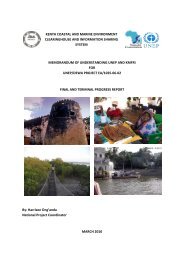
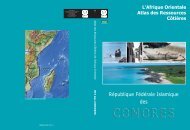
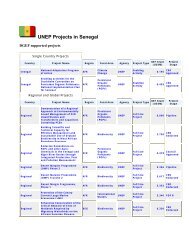

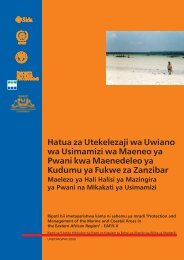
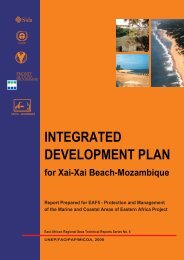
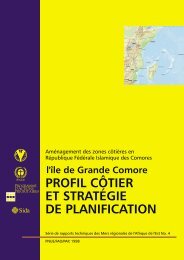
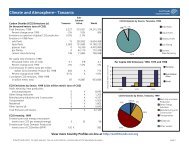

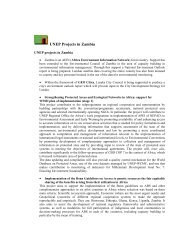
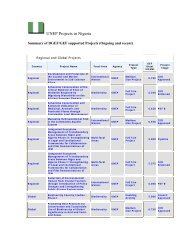
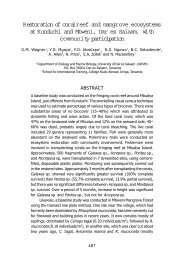
![Please Click to download [English] - GRID Africa GeoPortal - UNEP](https://img.yumpu.com/30633391/1/184x260/please-click-to-download-english-grid-africa-geoportal-unep.jpg?quality=85)
